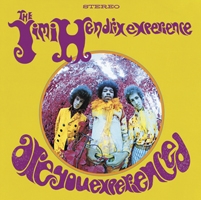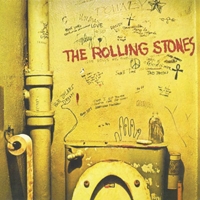The Top 50 Albums of All Time Page 3

16: Led Zeppelin: Led Zeppelin II (Atlantic)
This 1969 recording gave me my first lesson in stereo. As a pre-teen, I bought the cassette version for listening on my portable Panasonic player - and I spent 3 years unknowingly listening to only the left channel. I didn't even know that "Whole Lotta Love" had a guitar solo until the song came on the radio one day and I heard notes that weren't on my copy of the album. The cassette also jumbled the running order, placing "Heartbreaker" at the end of Side 1 and "Thank You" at the beginning of Side 2 - which, as any dedicated fan of this album can tell you, is just plain wrong. - ROB O'CONNOR

17: Love: Forever Changes (Elektra; Rhino)
My first brush with Arthur Lee's complicated genius was in 1971 when Ben Edmonds put this album on the office turntable at Creem magazine, where we worked. Never mind that this was 4 years after the record's release; it still had the power to enthrall, with its blend of state-ly symphonic arrangements, Youthquake angst, and narcoleptic, often enigmatic lyrics. Those words posed more questions than they answered, whether in the troubling blood transfusions of "A House Is Not a Motel" (which seemed to foretell Lee's death, in 2006, from leukemia) or the chilling Cold War imagery of "The Red Telephone." "Andmoreagain" is more medieval court song than rock song, inspired by Androulla Morenoa, who was the girlfriend of both Lee and guitarist Bryan MacLean - making material the complicated relations in this era of peace and love. - JAAN UHELSZKI

18: Bruce Springsteen: Born to Run (Columbia)
The title song - Springsteen's attempt to re-create "the sound of universes colliding" (as he'd famously described some of Phil Spector's hits) - had been leaked to DJs in the months before this came out in the summer of 1975. So Bruce's insanely faithful fans (among whom I most definitely counted myself) were primed for a masterpiece. Which we got, in spades. He may have made deeper and richer music (I still prefer The Wild, the Innocent & the E Street Shuffle), but between the fuel-injected guitars of "Thunder Road" and the light-years-beyond-gorgeous street-corner romanticism of "Jungleland," Born to Run contained, if not universes, then at least multitudes. - STEVE SIMELS

19: The Jimi Hendrix Experience: Are You Experienced (Reprise; Experience Hendrix)
The first time I plopped this 1967 debut onto my JVC turntable, I quickly agreed that Jimi Hendrix had brought the electric guitar into an entirely new realm. But I also soon discovered that the album revealed tunes that were insanely catchy ("Purple Haze"), brilliantly bluesy ("Hey Joe," "Red House"), otherworldly (the title track), and fire-breathing ("Foxey Lady") because of the way Hendrix's immensely creative guitar blended with his passionate vocals and the dynamic playing of bassist Noel Redding and drummer Mitch Mitchell. This isn't just the initial triumph of a guitar god, but a unique piece of rock and blues genius. - JEFF PERLAH

20: The Beatles: Rubber Soul (Capitol)
Nobody really noticed it at the time, but 1965's Rubber Soul was in fact the Beatles' first album obviously conceived from stem to stern as a unified artistic statement - not perhaps a concept record in the subsequent Sgt. Pepper sense, but a consistently brilliant work in which each individual track had a similar aural signature (the rock & roll band as chamber-music ensemble). Brian Wilson called it the first rock album without filler, which isn't far from the truth. Whether it's Paul McCartney singing in French ("Michelle") or John Lennon trying to describe an affair without his wife knowing about it, and getting poetry as a result ("Norwegian Wood"), the Beatles' level of sophistication here is astounding compared with that of the vaguely punkish bar band that had recorded its debut a mere 3 years before. - STEVE SIMELS

21: AC/DC: Back in Black (Atlantic; Columbia/Legacy)
Contrary to possible popular belief, this is not a three-song EP. Granted, if truth be told, the 13 minutes of "Hells Bells" (no apostrophe!), "Back in Black," and "You Shook Me All Night Long" are stronger than some other bands' entire 70-minute CDs. But headbangers old/young should be reminded/instructed that there's much more on this 1980 record than what they hear on the radio. "Givin the Dog a Bone" (no apostrophe!), "Let Me Put My Love into You," "Shake a Leg," and on and on - that's a whole lotta riffs, Rosie, with no-nonsense production by Robert John "Mutt" Lange. "Rock and Roll Ain't Noise Pollution": Truer words were never sung. - KEN RICHARDSON

22: Iggy and the Stooges: Raw Power (Columbia)
As a 13-year-old kid who devoured Creem and Circus, I started to think of Lester Bangs and his compatriots as my smart-assed older brothers. And in 1973, Raw Power was the album that none of them would shut up about for months. I finally bought it sound-unheard, since even underground FM radio in the New York City area wasn't touching it. Gearing up for a full-blast assault, I was initially shocked at how catchy and melodic the album turned out to be; it still stands as proof that great punk is, among other things, about songwriting. Still, there was enough in these songs to suggest that postadolescence was, uh, going to be interesting. - BRETT MILANO

23: The Beach Boys: Pet Sounds (Capitol)
It's been more than 40 years since this album appeared in 1966, and I have yet to hear a single recording from any other era, before or after, that comes close to matching it in spatial depth and texture - and this from an album crafted in mono sonics, mind you. Brian Wilson surpassed spiritual mentor Phil Spector's Wall of Sound productions by single-handedly creating a fully three-dimensional model, exemplified by the eternal "God Only Knows." Pet Sounds has everything from French horns, harpsichords, and bass harmonicas to theremins, bicycle bells, and yes, barking dogs. It remains not only Brian's greatest achievement, but arguably all of 20th-century American pop music's as well. - BILLY ALTMAN

24: The Rolling Stones: Sticky Fingers (Rolling Stones/Atlantic; Hip-O)
As a kid in 1971, flipping through bins of LPs at Record World or Korvette's (or some other long-gone establishment), whenever I spied Andy Warhol's cover for Sticky Fingers, I felt uneasy. There was something about those jeans, with their real zipper, that seemed so . . . loaded. The LP itself, of course, contained some of the Stones' best songs: "Wild Horses," "Can't You Hear Me Knocking," "Bitch," "Brown Sugar." Then there were the slow-burn blues numbers, and even a great country song ("Dead Flowers"). If you could have only one Stones album in your collection, this should be it. - AL GRIFFIN

25: The Who: Quadrophenia (MCA)
Whatever you think of Ken Russell's film version of Tommy, the Who's performances for that 1975 movie were powerhouse - so much so that, when I needed my Who fix thereafter, the relatively tame original Tommy album no longer did it for me. Instead, I turned to 1973's Quadrophenia, which had the band at the peak of its powers: Pete Townshend's writing was more mature, John Entwistle and Keith Moon were playing ever more frenetically, and Roger Daltrey was belting out his vocals with true rock-operatic gusto. Toss in the cool concept of the protagonist's four identities, each associated with a different member of the band, and I was hooked. The Who never topped this one. - ANDREW NASH

26: The Rolling Stones: Beggars Banquet (London; ABKCO)
With their finger in the wind, the Rolling Stones sensed and channeled the storms that were stirring in the counterculture. And it was on Beggars Banquet that they tore free of their follow-the-leader ties to the Beatles. They were literally diabolical on "Sympathy for the Devil" and grandly provocative on "Street Fighting Man." After the psychedelic overkill of 1967's Their Satanic Majesties Request (their Sgt. Pepper retort), it's not surprising that much of this album also found the Stones embracing their stylistic roots in acoustic blues, with songs whose sly, sexual distemper and jaundiced spirits likewise suited the souring mood in the colossal bringdown year of 1968. - PARKE PUTERBAUGH

27: The Who: Tommy (MCA)
It was the spring of 1970, and I was witnessing Woodstock - Michael Wadleigh's film of the previous summer's festival. (Among the editors of that film: Martin Scorsese.) Suddenly, one of the bands nearly blasted me out of my seat. "The Who," my older brother informed me, just as they performed from their rock opera about a deaf, dumb, and blind boy. I left the theater swinging my arm like a windmill. Over time, however, I haven't needed any air-guitar heroics or actual smashed gear to go back and appreciate Pete Townshend's original miracle of songwriting - an album that was released only 3 months before he took the stage in front of 300,000 people at Max Yasgur's farm. Told through Pete's bevy of guitar styles, Roger Daltrey's passionate singing, John Entwistle's commanding bass, and Keith Moon's manic yet magisterial drumming, Tommy is a truly amazing journey. - JEFF PERLAH

28: John Lennon: Plastic Ono Band (Apple; Capitol)
1970. The bell tolls. "Mother." Screaming. Raw. Real. Too real? Too bad. Lennon's lyrics and vocals, naked and exposed. His guitars, gutsy and dirty. Klaus Voormann and Ringo Starr, rhythm-section simplicity. The three of them get in a mood together, letting the songs and the emotions be the stars. "I Found Out." Angry. "Love is real / Real is love." Tender. "God." Stark. A revelation. Ringo's taut tom fills, Billy Preston's spiritual piano riffs. "The dream is over. . . ." Shocking. No veils, no compromises. Plastic Ono Band. Never plastic. Oh no. - MIKE METTLER

29: The Doors: The Doors (Elektra; Rhino)
This 1967 debut arrived in the Summer of Love with a darkly existential sound and message that ran counter to the smile-on-your-brother tone of the times. Jim Morrison's ingestion of literature and hallucinogens lent an unapologetic depth to his lyrical exploration of the subconscious. "Light My Fire," written by guitarist Robby Krieger, was the hit. "The End," an 11-minute opus by Morrison, was the shocker, touching on psychic disorientation and death. The set's nine other, briefer songs were explosive nuggets. And today, still, the whole thing is best experienced in its powerful mono mix. - PARKE PUTERBAUGH

30: The Beatles: The Beatles (Apple; Capitol)
Looking back to 1968, you can really hear the beginnings of their breakup musically, as all four Beatles start to pull apart from each other and head in what would be, within a year and a half, completely separate solo directions. Cases in point: Paul McCartney's music-for-music's-sake acoustic ditty "Mother Nature's Son" is immediately followed by John Lennon's in-your-face electric rocker "Everybody's Got Something to Hide Except Me and My Monkey." Then again, "The White Album" is still the Beatles, and their only double studio LP remains a true embarrassment of riches. - BILLY ALTMAN
- Log in or register to post comments



































































